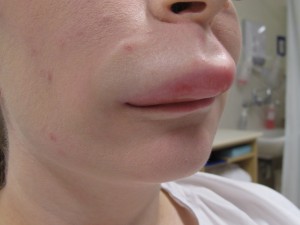Hives (urticarial) are itchy superficial skin swellings. They look pale red, raised and puffy in the center (wheals). Individual hives vary in size. They are often transient, lasting a few hours to less than 48 hours. About 40% of hives come with angioedema (swelling in deep layers of the skin). They result from histamine release in the skin, causing small blood vessels to leak and skin to swell up.
Hives are generally classified as acute vs chronic. Acute urticaria refers to completely resolution of outbreak in 6 weeks. If the disease course lasts for more than 6 weeks, it is defined as chronic urticaria. Most cases of urticaria are acute. Hives can be triggered by allergies to foods, environmental allergens, medications, insect stings, etc, or non-allergic stimuli, such as viral illness, sweating, cold, heat, pressure, scratching, emotional stress, etc. Chronic urticaria, on the other hand, is rarely caused by specific triggers, and allergy tests are usually not helpful. It is mostly idiopathic (the cause is unknown) or autoimmune (against own body) in origin. Your doctor may consider performing some blood tests to rule out a few medical conditions that may be associated with chronic urticaria, such as thyroid disease. Chronic urticaria can last for many months or years.
The main stay treatment of hives is anti-histamines. Managing chronic urticaria sometimes can be tricky. Additional medications including oral steroid or immunomodulators may be used in refractory cases. A biological agent, Xolair (Omalizumab), is now approved by the FDA for treating chronic idiopathic urticaria in adults and adolescents 12 years of age and older who remain symptomatic despite H1 antihistamine treatment.
Angioedema may occur with or without hives. It is commonly seen in soft tissues such as eyelids, lips or genital, but can occur in hands, feet, intestinal wall or throat. Angioedema caused by histamine release can be managed the same way as hives. However, some rare types of angioedema, hereditary angioedema (HAE) and acquired angioedema (AAE), are not caused by histamine release but by deficiency in the C1 inhibitor pathway. Special lab tests are needed for diagnosis, and management is completely different from managing urticaria.
Some people on a class of blood pressure medicines called angiotensin-converting-enzyme inhibitors (ACE inhibitors, such as Captopril, Enalapril, Ramipril, Lisinopril) may develop angioedema anytime when on the medication. It is important to consult your doctor if you have such a condition, and switch to an alternative medication.

